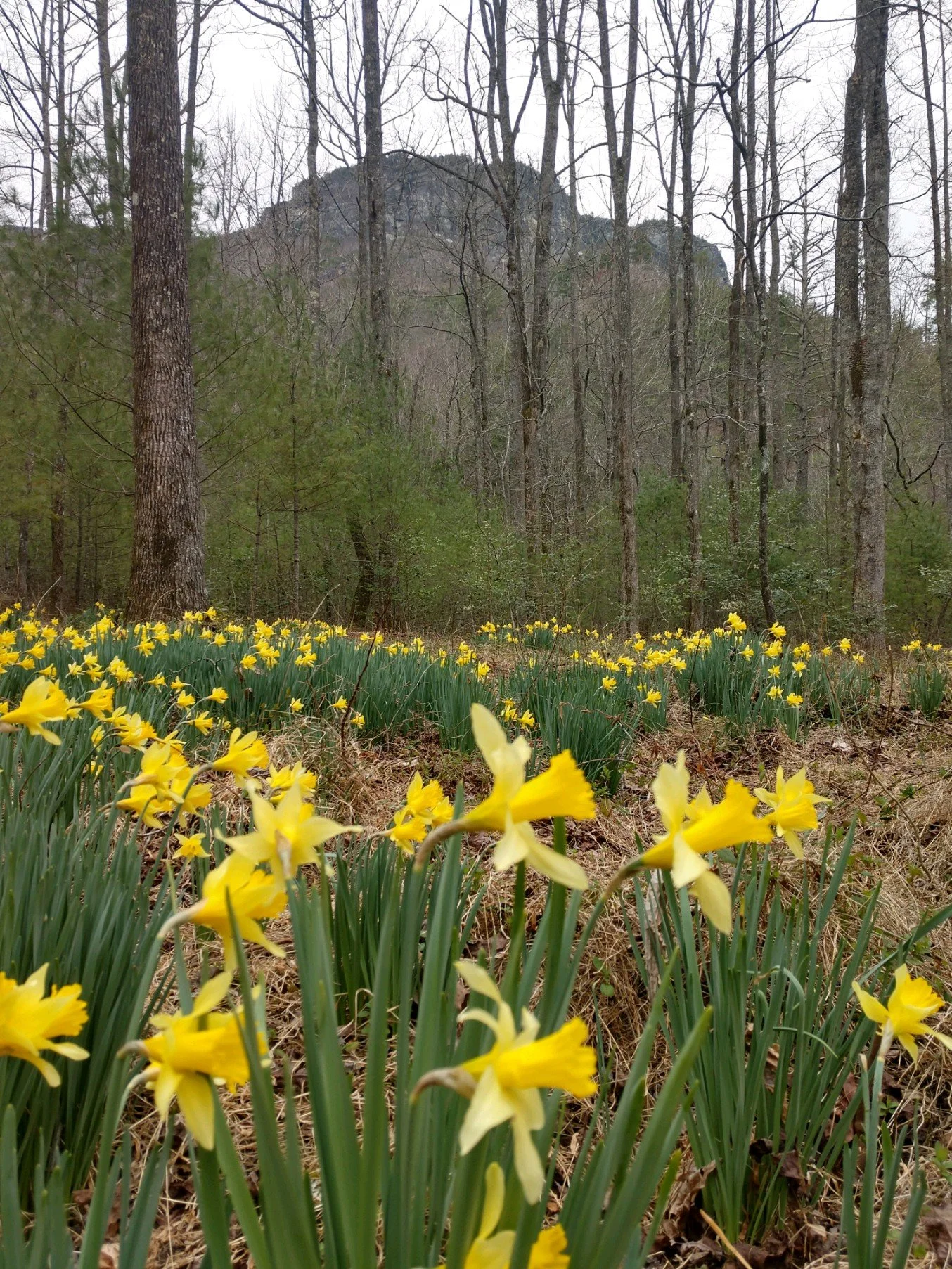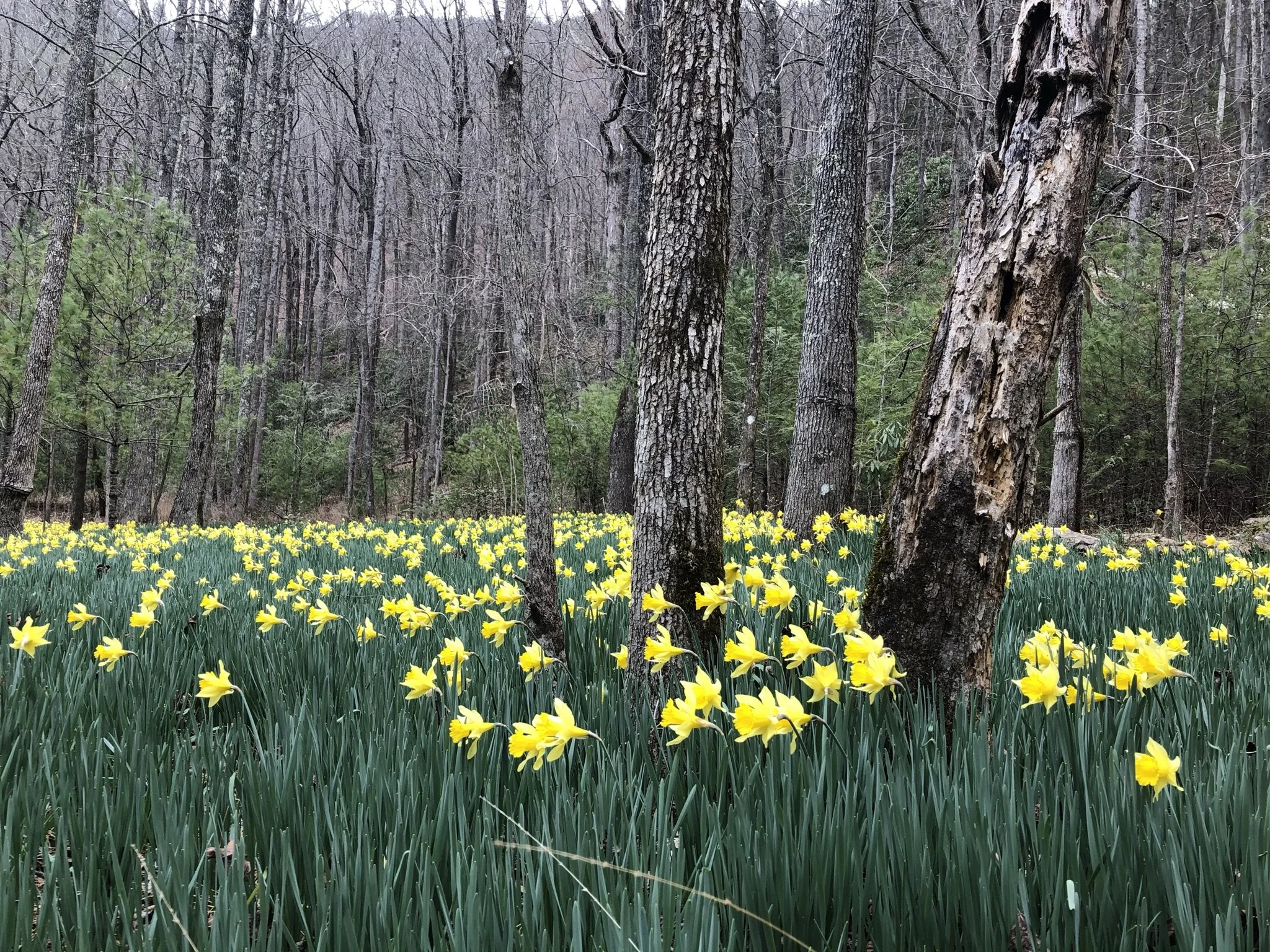Ghost maps and relational realit
By Lissa Carter, LCMHC
This time of the year, there is a hike I love to take down into the river gorge where daffodils blanket the forest floor. The story goes that a woman, unhappily transplanted to this isolated homestead in the mountains, put a few daffodil bulbs into the ground to try and brighten her days. The homestead is long since flooded and gone, but the daffodils remain, spreading and multiplying through the woods to mark the place she once lived.
Daffodils form a kind of ghost map, a secret clue to the history of a place. Someone had to plant them, and so wherever there are daffodils there is the story of a person who loved them. Near my home there is a vacant lot. The absence of trees indicates the faint echo of where a driveway once curved, and in the spring blooming daffodils outline what must once have been the entry to the house.
When I studied nettles, I learned that because of their nutritional requirements, they can often be found growing in old homesites where the dwellers had their compost pile. Often once you find a patch of nettles you can walk a radius around them to locate an old chimney or foundation stones. It’s a great way to show off to friends and family (although, it must be said, they are never quite as impressed as one might hope.)
Ghost maps show us what was when we tune into what is. There are botanical ghost maps, weather ghost maps (early morning clouds trace the parts of the earth below that are first to warm), and political ghost maps (I learned in a long-ago anthropology class that the most vehemently misogynistic cultures offer a ghost map of the geographical areas that historically had traditions of female empowerment, because of the retaliatory nature of politics).
How is this relevant to therapy?
Well, the hike up from the daffodils at the river bottom is steep, with persistent elevation gains for three miles straight. You get to witness a parade of coping strategies in those around you and within your own mind, if you pay attention.
When we first discovered this hike, my husband got frustrated with me for hiking ahead and leaving him behind. We could easily have turned this into a full-blown argument, with accusations of selfishness and neediness flying around. But if, instead, we could see the ghost maps—the little girl who absorbed biographies of George Fox and John Woolman, determined to develop grit—the neglected little boy who had to learn to be insistent and vocal to get his needs met—we could navigate the web of relational reality that is so different from what we think of as objective truth.
The past leaves its thumbprint on us. Once we have awoken to a pattern of behavior, we have the thumbprint—the ghost map. It tells us a story about the thumb—the thing that happened in the past that taught us to behave this way.
Our relational models are built in equal part by internalizing what we were exposed to (as James Baldwin observed, “Children have never been very good at listening to their elders, but they have never failed to imitate them”) and reacting against it. So we may find ourselves, inexplicably, lashing out violently in response to a relational trigger one day, and just a few days later responding to the same occurrence by shutting down entirely.
If we can understand the hidden nutrients beneath these nettles, we can treat ourselves with greater compassion and understanding. And we can access more patience when the people we love behave in confusing and irrational ways.
Next time you find yourself confused by your own behavior, or the behavior of someone you love, ask yourself or your loved one these four questions, adapted from the work of Terry Real:
“Who behaved this way when you were growing up?”
“Who acted this behavior out on you?”
“When did you enact this behavior as a child without anyone stopping you?”
“Who hurt you by behaving the opposite of the way you are behaving?”
As humans, we love reasons. In one famous study, participants were split into three groups. One group was told to butt ahead in line without giving a reason. Another was told to give a plausible reason, and a third was told to give an irrational reason. It turned out that although the people waiting in line were angered by the behavior of butting in line without offering an explanation, they were pacified equally by reasons as logical as “I have to go ahead of you because my partner is in labor” and reasons as implausible as “I have to get ahead of you because I had cereal for breakfast.”
If we have a reason for the way we are acting, we can generate more compassion and understanding. This leads to healthier relationships, fewer arguments, and a deeper understanding of our own lives and the lives of those we love.
Noticing ghost maps is a beautiful way to begin tracking and understanding our layered relational realities… the foundation stones below the lines of daffodils.
If you are interested in your own inner worlds and wish to explore the meaning of your dreams, join Lissa and Julie for a daylong dreamwork retreat this September. Click the image below for more information.




